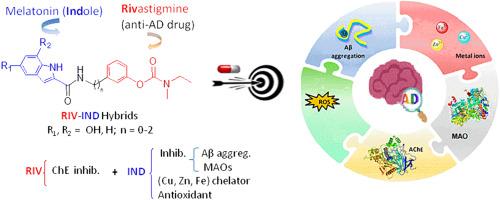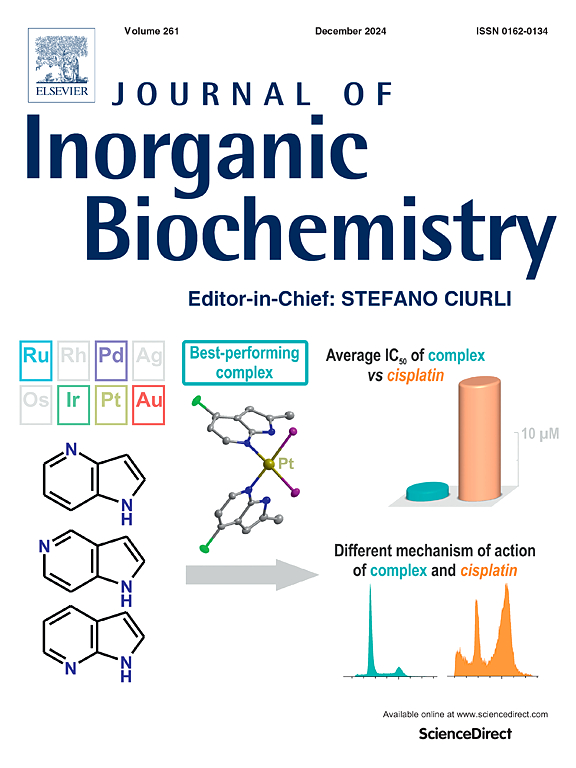Exploiting the potential of rivastigmine-melatonin derivatives as multitarget metal-modulating drugs for neurodegenerative diseases
IF 3.8
2区 化学
Q2 BIOCHEMISTRY & MOLECULAR BIOLOGY
引用次数: 0
Abstract
The multifaceted nature of the neurodegenerative diseases, as Alzheimer's disease (AD) and Parkinson's disease (PD) with several interconnected etiologies, and the absence of effective drugs, led herein to the development and study of a series of multi-target directed ligands (MTDLs). The developed RIV-IND hybrids, derived from the conjugation of an approved anti-AD drug, rivastigmine (RIV), with melatonin analogues, namely indole (IND) derivatives, revealed multifunctional properties, by associating the cholinesterase inhibition of the RIV drug with antioxidant activity, biometal (Cu(II), Zn(II), Fe(III)) chelation properties, inhibition of amyloid-β (Aβ) aggregation (self- and Cu-induced) and of monoamine oxidases (MAOs), as well as neuroprotection capacity in cell models of AD and PD. In particular, two hybrids with hydroxyl-substituted indoles (5a2 and 5a3) could be promising multifunctional compounds that inspire further development of novel anti-neurodegenerative drugs.

挖掘利伐斯的明-褪黑素衍生物作为多靶点金属调节药物治疗神经退行性疾病的潜力。
神经退行性疾病(如阿尔茨海默病(AD)和帕金森病(PD))的病因多种多样,且相互关联,缺乏有效的药物,因此开发和研究了一系列多靶点定向配体(MTDL)。所开发的 RIV-IND 混合物由已获批准的抗老年痴呆症药物利伐斯的明(RIV)与褪黑素类似物(即吲哚(IND)衍生物)共轭而成,通过将 RIV 药物的胆碱酯酶抑制作用与抗氧化活性结合起来,显示出多功能特性、生物金属(Cu(II)、Zn(II)、Fe(III))螯合特性,抑制淀粉样蛋白-β(Aβ)聚集(自身和铜诱导)和单胺氧化酶(MAOs),以及在注意力缺失症(AD)和帕金森氏症(PD)细胞模型中的神经保护能力。特别是与羟基取代的吲哚(5a2 和 5a3)的两种混合物可能是很有前途的多功能化合物,有助于进一步开发新型抗神经退行性疾病药物。
本文章由计算机程序翻译,如有差异,请以英文原文为准。
求助全文
约1分钟内获得全文
求助全文
来源期刊

Journal of Inorganic Biochemistry
生物-生化与分子生物学
CiteScore
7.00
自引率
10.30%
发文量
336
审稿时长
41 days
期刊介绍:
The Journal of Inorganic Biochemistry is an established international forum for research in all aspects of Biological Inorganic Chemistry. Original papers of a high scientific level are published in the form of Articles (full length papers), Short Communications, Focused Reviews and Bioinorganic Methods. Topics include: the chemistry, structure and function of metalloenzymes; the interaction of inorganic ions and molecules with proteins and nucleic acids; the synthesis and properties of coordination complexes of biological interest including both structural and functional model systems; the function of metal- containing systems in the regulation of gene expression; the role of metals in medicine; the application of spectroscopic methods to determine the structure of metallobiomolecules; the preparation and characterization of metal-based biomaterials; and related systems. The emphasis of the Journal is on the structure and mechanism of action of metallobiomolecules.
 求助内容:
求助内容: 应助结果提醒方式:
应助结果提醒方式:


